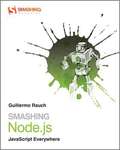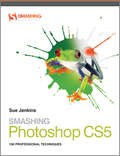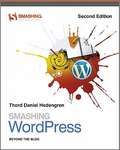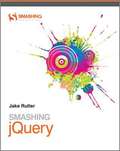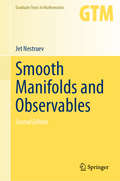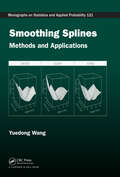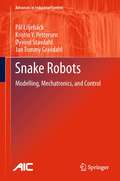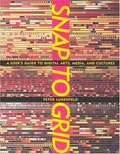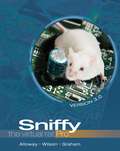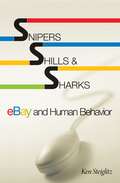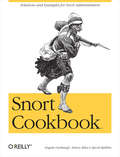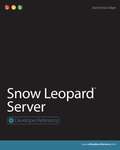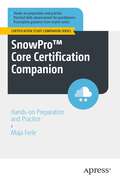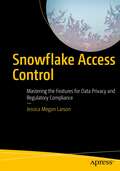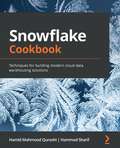- Table View
- List View
Smashing Node.js
by Guillermo RauchLearn to make more efficient apps, with just one language!Smashing Node.js: JavaScript Everywhere equips you with the necessary tools to understand Node.js and its uses in developing efficient web apps. With more traditional web servers becoming obsolete, having knowledge on servers that achieve high scalability and optimal resource consumption using Node.js is the key to your app development success. Teaching you the essentials to making event-driven server-side apps, this book demonstrates how you can use less space and take less time for communication between web client and server.Contains numerous hands-on examplesExplains implementation of real-time apps including Socket.IO and HTML5, and WebSocketsAddresses practical Node.js advantages from specific design choicesDemonstrates why knowledge and use of JavaScript is beneficial Includes an interactive online component with sample chaptersExplains components of stand out apps including brevity and benchmarksLooking to enhance your abilities even further? Smashing Node.js: JavaScript Everywhere makes developing server-side apps accessible with its focus on JavaScript, open source, and easy-to-use language.
Smashing Photoshop CS5
by Sue JenkinsEXPAND YOUR IMAGINATIONSmashing Photoshop CS5 is loaded with 100 creative and innovative techniques to help jump-start your creativity and inspire you to do more with your designs and photographs. This book is aimed at designers, artists and photographers who want to become proficient in Photoshop CS5, getting you quickly up to speed with many of the fantastic new tools and features.Author Sue Jenkins is a photographer and web and graphic designer, author, software instructor and Adobe Certified Expert. Using her knowledge and years of expertise in the field she provides 100 hints, special effects, and techniques that will enable you to extend your existing skills and to develop and execute new ideas and trends.Smashing Photoshop CS5 is the ideal guide to help you to get the best out of Photoshop CS5. This book will teach you how to perform specific tasks using a variety of tools, filters, styles, adjustment layers, and more.With Smashing Photoshop CS5 you will learn how to: * MAKE 3D TEXT WITH REPOUSSÉ* CREATE ENGRAVED TYPE* DESIGN A BLOG HEADER* STIMULATE HIGH DYNAMIC RANGE IMAGES* MAKE RETRO HALFTONES* WORK WITH CUSTOM BRUSHES* USE CONTENT-AWARE SCALING* TRANSFORM WITH PUPPET WARP* TRACE PHOTOS* MAKE SCALE MODELS* MIMIC CROSS-PROCESSING (XPRO)* EDIT WITH LAYER MASKS* CORRECT IMAGE DISTORTION* RETOUCH AND RESTORE IMAGES* EDIT WITH THE VANISHING POINT* CREATE PANORAMASKey Topics Covered: Part I: Web Layout And OptimizationPart II: Photoshop CS4 And CS5 TechniquesPart III: Text EffectsPart IV: Studio And Commercial EffectsPart V: Special EffectsPart VI: Image DistressingPart VII: Image Retouching And RestorationSmashing Photoshop CS5 is the perfect springboard for sparking new ideas and gaining inspiration for all your projects.Smashing Magazine (smashingmagazine.com) is one of the world's most popular web design sites. True to the Smashing mission, the Smashing Magazine book series delivers useful and innovative information to Web designers and developers.
Smashing WebKit
by Jon RaaschThe ultimate guide to WebKit from the world's most popular resource for web designers and developersAs the default browser for both iPhone and Android, WebKit has become a major player in the mobile arena, offering a wider array of HTML5 and CSS3 support than any other major engine. Written by expert author Jon Raasch, this essential book teaches you how to use WebKit to make web sites more engaging, faster, and more visually appealing. You'll explore the variety of unique interface options that WebKit offers as you quickly discover how to create a unique web experience that provides functionality and entertainment. Packed with best practices, real-world examples, and invaluable advice, this must-have guide explores WebKit's capabilities, recommended techniques, and tips for improving an existing web site. Plus, whenever possible, cross-browser support is discussed for WebKit solutions as well as a wide variety of advanced presentation and interactivity options.Gets you started with WebKit and shows you how to maximize HTML5 and CSS3 features in WebKitAddresses ways to optimize your web site for mobile devices and enhance the mobile user experienceFeatures numerous examples, tips, techniques, and advice for getting the most out of WebKitThis book escorts you through a myriad of ways that WebKit can set your web site apart from the competition.
Smashing WordPress
by Thord Daniel HedengrenThe ultimate guide to using WordPress to make your life easierWordPress guru Thord Daniel Hedengren takes you beyond the blog to give you the tools and know-how needed to build just about anything in WordPress. You'll discover how to use WordPress as a CMS to power fully-fledged websites, photo galleries, forums, eCommerce sites, and much more. You get step-by step instructions on developing model sites from the ground up and how to utilize and build plugins that let you take WordPress to the next level.You will learn how to:· Use custom post types and custom taxonomies· Add and work with custom headers, backgrounds, and more· Build gorgeous WordPress themes with the latest features· Create custom login forms and admin themes· Control content with the loop (and alternatives to the loop)· Integrate theme options and the theme customizer· Extend WordPress with widget functionality· Build WordPress projects for SEO· Integrate WordPress with the social web· Create helpful navigation using the navigation menu· Use conditional control elements· Get started with your own responsive themes Updated and revised to cover the changes to WordPress 3.8, Smashing WordPress: Beyond the Blog, 4th Edition, is the ultimate guide to getting the most out of WordPress.
Smashing WordPress Themes
by Thord Daniel HedengrenThe ultimate guide to WordPress Themes - one of the hottest topics on the web today WordPress is so much more than a blogging platform, and Smashing WordPress Themes teaches readers how to make it look any way they like - from a corporate site, to a photography gallery and moreWordPress is one of the hottest tools on the web today and is used by sites including The New York Times, Rolling Stone, flickr, CNN, NASA and of course Smashing MagazineBeautiful full colour throughout - web designers expect nothing lessSmashing Magazine will fully support this book by by promoting it through their website and on twitter feeds
Smashing jQuery
by Jake RutterFrom the world's most popular resource for web designers and developer's comes the ultimate guide to jQueryBegins with an exploration of fundamental jQuery concepts such as Document Object Model (DOM) scriptingExplores writing "Don't Repeat Yoursefl" (DRY) to gain a comprehensive understanding of these imperative modern techniques and best practicesShows how jQuery enables the user to adhere to these modern best practices with easeThe succeeding chapters discuss a specific part of jQuery development such as manipulating the DOM, working with Ajax, and adding slick animation effects through tutorial style learning approach that utilizes working examples to explore the conceptThe books caps off by discussing popular ways of extending the core jQuery library with pugins and building web interfaces using jQuery UI
Smiley. Herzchen. Hashtag.: Zwischenmenschliche Kommunikation im Zeitalter von Facebook, WhatsApp, Instagram @ Co. (Über/Strom: Wegweiser durchs digitale Zeitalter)
by Uta ButtkewitzLieber eine schnelle Sprachnachricht als ein persönlicher Anruf, ein Smiley statt eines Grußes – die Kommunikation verändert sich im digitalen Zeitalter. Kommunikation wird unverbindlich, aber gleichzeitig steigt der Kommunikationsdruck durch soziale Medien und Netzwerke. Wir stehen unter Druck, jederzeit schnell zu kommunizieren. In Ruhe einen Kaffee trinken, die Aussicht genießen? Geht nicht, jede WhatsApp muss umgehend beantwortet werden und die Likes unter dem Foto zählen mehr als der Genuss des Augenblicks. Viel zu kurz kommt bei all dem die zwischenmenschliche Kommunikation.Dieses Buch zeigt, wie aktuelle Kommunikationsmedien wie WhatsApp, Facebook oder Instagram die zwischenmenschliche Kommunikation beeinflussen und wie diese Veränderungen unsere Beziehungen und unser gesellschaftliches Zusammenleben schleichend verändern. Die Verfügbarkeit einer Vielzahl von Medien stellt uns vor große Herausforderungen. Wenn Sie sich schon immer gefragt haben, warum das Kommunizieren im Privat- oder Berufsleben plötzlich schwieriger geworden ist, finden Sie in diesem Buch Antworten darauf. Sie lernen, wie Sie im digitalen Zeitalter bei sich bleiben und sich nicht von kurzfristigen Erregungszuständen der Medien aus dem Gleichgewicht bringen lassen. Treffen Sie bewusste Entscheidungen für Medien und ihre Nutzung und erobern Sie Ihre kommunikative Selbstbestimmung zurück!
Smoke & Mirrors: How Hype Obscures the Future and How to See Past It
by Gemma Milne'Stop following the news until you've read Gemma Milne's persuasive analysis of the hype and bullshit that distort our understanding of emerging science. As she shows, the starting point to grasping the genuine opportunities of AI, life sciences and climate tech is a healthy dose of critical thinking'David Rowan, founding editor of WIRED UK and author of Non-Bullshit Innovation: Radical Ideas from the World's Smartest Minds'Couldn't be more timely. Fascinating and vitally important'Jamie Bartlett, author of The People Vs Tech'A much-needed blast of fresh air! Gemma Milne expertly shows us how to separate the truth from the hype surrounding the emerging techs of today, and those of the near-tomorrow'Lewis Dartnell, author of Origins: How the Earth Made Us'I loved this book! This is exactly the sort of sceptical, cut-through-the crap-but-still-excited-about-what's-emerging book around tech innovation that's sorely needed, yet is so hard to find . . . essential reading for anyone who's serious about how real-world advances might be effectively harnessed to build a better future'Dr Andrew Maynard, scientist and author of Films from the Future and Future Rising'[A] vital contribution in a world where technological progress promises so much, but too often disappoints. If, like me, you believe that advances in science and technology are our best hope for solving the grand challenges of our times, this book is the indispensable guide to avoiding the mirages and the charlatans along the way'Matt Clifford, co-founder and CEO of Entrepreneur First'A refreshingly grown-up, clear-headed look at the interaction between science, technology and the media - readable without being dumbed down, acknowledging complexities without being heavy'Tom Chivers, author of The AI Does Not Hate You'ROBOTS WILL STEAL YOUR JOB!''AI WILL REVOLUTIONISE FARMING!''GENETIC EDITING WILL CURE CANCER!'Bombastic headlines about science and technology are nothing new. To cut through the constant stream of information and misinformation on social media, or grab the attention of investors, or convince governments to take notice, strident headlines or bold claims seem necessary to give complex, nuanced information some wow factor.But hype has a dark side, too.It can mislead. It can distract. It can blinker us from seeing what is actually going on.From AI, quantum computing and brain implants, to cancer drugs, future foods and fusion energy, science and technology journalist Gemma Milne reveals hype to be responsible for fundamentally misdirecting or even derailing crucial progress.Hype can be combated and discounted, though, if you're able to see exactly where, how and why it is being deployed.This book is your guide to doing just that.
Smoke & Mirrors: How Hype Obscures the Future and How to See Past It
by Gemma Milne'Stop following the news until you've read Gemma Milne's persuasive analysis of the hype and bullshit that distort our understanding of emerging science. As she shows, the starting point to grasping the genuine opportunities of AI, life sciences and climate tech is a healthy dose of critical thinking'David Rowan, founding editor of WIRED UK and author of Non-Bullshit Innovation: Radical Ideas from the World's Smartest Minds'Couldn't be more timely. Fascinating and vitally important'Jamie Bartlett, author of The People Vs Tech'A much-needed blast of fresh air! Gemma Milne expertly shows us how to separate the truth from the hype surrounding the emerging techs of today, and those of the near-tomorrow'Lewis Dartnell, author of Origins: How the Earth Made Us'I loved this book! This is exactly the sort of sceptical, cut-through-the crap-but-still-excited-about-what's-emerging book around tech innovation that's sorely needed, yet is so hard to find . . . essential reading for anyone who's serious about how real-world advances might be effectively harnessed to build a better future'Dr Andrew Maynard, scientist and author of Films from the Future and Future Rising'[A] vital contribution in a world where technological progress promises so much, but too often disappoints. If, like me, you believe that advances in science and technology are our best hope for solving the grand challenges of our times, this book is the indispensable guide to avoiding the mirages and the charlatans along the way'Matt Clifford, co-founder and CEO of Entrepreneur First'A refreshingly grown-up, clear-headed look at the interaction between science, technology and the media - readable without being dumbed down, acknowledging complexities without being heavy'Tom Chivers, author of The AI Does Not Hate You'ROBOTS WILL STEAL YOUR JOB!''AI WILL REVOLUTIONISE FARMING!''GENETIC EDITING WILL CURE CANCER!'Bombastic headlines about science and technology are nothing new. To cut through the constant stream of information and misinformation on social media, or grab the attention of investors, or convince governments to take notice, strident headlines or bold claims seem necessary to give complex, nuanced information some wow factor.But hype has a dark side, too.It can mislead. It can distract. It can blinker us from seeing what is actually going on.From AI, quantum computing and brain implants, to cancer drugs, future foods and fusion energy, science and technology journalist Gemma Milne reveals hype to be responsible for fundamentally misdirecting or even derailing crucial progress.Hype can be combated and discounted, though, if you're able to see exactly where, how and why it is being deployed.This book is your guide to doing just that.
Smoke & Mirrors: How Hype Obscures the Future and How to See Past It
by Gemma Milne'Stop following the news until you've read Gemma Milne's persuasive analysis of the hype and bullshit that distort our understanding of emerging science. As she shows, the starting point to grasping the genuine opportunities of AI, life sciences and climate tech is a healthy dose of critical thinking'David Rowan, founding editor of WIRED UK and author of Non-Bullshit Innovation: Radical Ideas from the World's Smartest Minds'Couldn't be more timely. Fascinating and vitally important'Jamie Bartlett, author of The People Vs Tech'A much-needed blast of fresh air! Gemma Milne expertly shows us how to separate the truth from the hype surrounding the emerging techs of today, and those of the near-tomorrow'Lewis Dartnell, author of Origins: How the Earth Made Us'I loved this book! This is exactly the sort of sceptical, cut-through-the crap-but-still-excited-about-what's-emerging book around tech innovation that's sorely needed, yet is so hard to find . . . essential reading for anyone who's serious about how real-world advances might be effectively harnessed to build a better future'Dr Andrew Maynard, scientist and author of Films from the Future and Future Rising'[A] vital contribution in a world where technological progress promises so much, but too often disappoints. If, like me, you believe that advances in science and technology are our best hope for solving the grand challenges of our times, this book is the indispensable guide to avoiding the mirages and the charlatans along the way'Matt Clifford, co-founder and CEO of Entrepreneur First'A refreshingly grown-up, clear-headed look at the interaction between science, technology and the media - readable without being dumbed down, acknowledging complexities without being heavy'Tom Chivers, author of The AI Does Not Hate You'ROBOTS WILL STEAL YOUR JOB!''AI WILL REVOLUTIONISE FARMING!''GENETIC EDITING WILL CURE CANCER!'Bombastic headlines about science and technology are nothing new. To cut through the constant stream of information and misinformation on social media, or grab the attention of investors, or convince governments to take notice, strident headlines or bold claims seem necessary to give complex, nuanced information some wow factor.But hype has a dark side, too.It can mislead. It can distract. It can blinker us from seeing what is actually going on.From AI, quantum computing and brain implants, to cancer drugs, future foods and fusion energy, science and technology journalist Gemma Milne reveals hype to be responsible for fundamentally misdirecting or even derailing crucial progress.Hype can be combated and discounted, though, if you're able to see exactly where, how and why it is being deployed.This book is your guide to doing just that.
Smooth Manifolds and Observables (Graduate Texts in Mathematics #220)
by Jet NestruevThis book gives an introduction to fiber spaces and differential operators on smooth manifolds. Over the last 20 years, the authors developed an algebraic approach to the subject and they explain in this book why differential calculus on manifolds can be considered as an aspect of commutative algebra. This new approach is based on the fundamental notion of observable which is used by physicists and will further the understanding of the mathematics underlying quantum field theory.
Smoothing Splines: Methods and Applications (Chapman & Hall/CRC Monographs on Statistics and Applied Probability)
by Yuedong WangA general class of powerful and flexible modeling techniques, spline smoothing has attracted a great deal of research attention in recent years and has been widely used in many application areas, from medicine to economics. Smoothing Splines: Methods and Applications covers basic smoothing spline models, including polynomial, periodic, spherical, t
Snake Robots
by Kristin Y. Pettersen Øyvind Stavdahl Jan Tommy Gravdahl Pål LiljebäckSnake Robots is a novel treatment of theoretical and practical topics related to snake robots: robotic mechanisms designed to move like biological snakes and able to operate in challenging environments in which human presence is either undesirable or impossible. Future applications of such robots include search and rescue, inspection and maintenance, and subsea operations. Locomotion in unstructured environments is a focus for this book. The text targets the disparate muddle of approaches to modelling, development and control of snake robots in current literature, giving a unified presentation of recent research results on snake robot locomotion to increase the reader's basic understanding of these mechanisms and their motion dynamics and clarify the state of the art in the field. The book is a complete treatment of snake robotics, with topics ranging from mathematical modelling techniques, through mechatronic design and implementation, to control design strategies. The development of two snake robots is described and both are used to provide experimental validation of many of the theoretical results. Snake Robots is written in a clear and easily understandable manner which makes the material accessible by specialists in the field and non-experts alike. Numerous illustrative figures and images help readers to visualize the material. The book is particularly useful to new researchers taking on a topic related to snake robots because it provides an extensive overview of the snake robot literature and also represents a suitable starting point for research in this area.
Snap to Grid: A User's Guide to Digital Arts, Media, and Cultures
by Peter LunenfeldIn Snap to Grid, an idiosyncratic guide to the interactive, telematic era, Peter Lunenfeld maps out the trajectories that digital technologies have traced upon our cultural imaginary.
Snapchat. ¡Guía del usuario para aplicaciones, filtros, emoji, lentes, fuentes, rachas y más!
by Carolina La Rosa Montilla Ken RogersUna guía paso a paso para usar y dominar Snapchat •Envío de Mensajes •Instalación y Configuración •Bitmojis •Snaps- Agregar Texto, Visualización, Guardar y Enviar Mensajes y Filtros. •Creación de Historias •Curaduría de Historias •Transferencias de Dinero ¡Y MUCHO MÁS! --> Desplázate hasta la parte superior de la página y haz clic en agregar al carrito para comprar al instante Descargo de responsabilidad: Este autor y/o propietario(s) de derechos no realizan afirmaciones, promesas o garantías sobre la exactitud, integridad o adecuación de los contenidos de este libro, y renuncian expresamente a la responsabilidad de errores u omisiones que puedan presentarse en los contenidos. Este producto es solo para uso de referencia.
Snapstreak: How My Friends Saved My (Social) Life
by Suzanne WeynEighth-grader Vee is doomed to move to a new town, away from her BFFs Megan and Lulu. To get a jump on her new social life, she starts snapping with local Queen Bee, Gwynneth. Megan and Lulu have mixed feelings about G., but Vee's snapstreak with her is well under way when they get the biggest news EVER: The local radio station is hosting a Boys Being Dudes concert for the pair of students from different schools who can prove the longest running snapstreak! Vee could win this!The girls' BBD dreams are in reach when a gym class concussion lands Vee in bed, under a strict phone ban. It's up to Megan and Lulu to keep the streak going.
Sniffy The Virtual Rat: Pro Version 3. 0
by Greg Wilson Tom Alloway Jeff GrahamMeet SNIFFY, THE VIRTUAL RAT! Using this CD-ROM and lab manual, you will get a hands-on experience in setting up and conducting experiments that demonstrate the phenomena of classical and operant conditioning using Sniffy the digital rat. Sniffy includes fifty exercises that cover every major phenomena typically covered in a Psychology of Learning course.
Snipers, Shills, and Sharks: eBay and Human Behavior
by Ken SteiglitzEvery day on eBay, millions of people buy and sell a vast array of goods, from rare collectibles and antiques to used cars and celebrity memorabilia. The internet auction site is remarkably easy to use, which accounts in part for its huge popularity. But how does eBay really work, and how does it compare to other kinds of auctions? These are questions that led Ken Steiglitz--computer scientist, collector of ancient coins, and a regular eBay user--to examine the site through the revealing lens of auction theory. The result is this book, in which Steiglitz shows us how human behaviors in open markets like eBay can be substantially more complex than those predicted by standard economic theory. In these pages we meet the sniper who outbids you in an auction's closing seconds, the early bidder who treats eBay as if it were an old-fashioned outcry auction, the shill who bids in league with the seller to artificially inflate the price--and other characters as well. Steiglitz guides readers through the fascinating history of auctions, how they functioned in the past and how they work today in online venues like eBay. Drawing on cutting-edge economics as well as his own stories from eBay, he reveals practical auction strategies and introduces readers to the fundamentals of auction theory and the mathematics behind eBay. Complete with exercises and a detailed appendix, this book is a must for sophisticated users of online auctions, and essential reading for students seeking an accessible introduction to the study of auction theory.
Snort Cookbook
by Jacob Babbin Simon Biles Angela D. OrebaughIf you are a network administrator, you're under a lot of pressure to ensure that mission-critical systems are completely safe from malicious code, buffer overflows, stealth port scans, SMB probes, OS fingerprinting attempts, CGI attacks, and other network intruders. Designing a reliable way to detect intruders before they get in is an essential--but often overwhelming--challenge. Snort, the defacto open source standard of intrusion detection tools, is capable of performing real-time traffic analysis and packet logging on IP network. It can perform protocol analysis, content searching, and matching. Snort can save countless headaches; the new Snort Cookbook will save countless hours of sifting through dubious online advice or wordy tutorials in order to leverage the full power of SNORT. Each recipe in the popular and practical problem-solution-discussion O'Reilly cookbook format contains a clear and thorough description of the problem, a concise but complete discussion of a solution, and real-world examples that illustrate that solution. The Snort Cookbook covers important issues that sys admins and security pros will us everyday, such as: installation, optimization, logging, alerting, rules and signatures, detecting viruses, countermeasures, detecting common attacks, administration, honeypots, log analysis But the Snort Cookbook offers far more than quick cut-and-paste solutions to frustrating security issues. Those who learn best in the trenches--and don't have the hours to spare to pore over tutorials or troll online for best-practice snippets of advice--will find that the solutions offered in this ultimate Snort sourcebook not only solve immediate problems quickly, but also showcase the best tips and tricks they need to master be security gurus--and still have a life.
Snort Cookbook: Solutions and Examples for Snort Administrators
by Jacob Babbin Simon Biles Angela OrebaughIf you are a network administrator, you're under a lot of pressure to ensure that mission-critical systems are completely safe from malicious code, buffer overflows, stealth port scans, SMB probes, OS fingerprinting attempts, CGI attacks, and other network intruders. Designing a reliable way to detect intruders before they get in is an essential--but often overwhelming--challenge. Snort, the defacto open source standard of intrusion detection tools, is capable of performing real-time traffic analysis and packet logging on IP network. It can perform protocol analysis, content searching, and matching. Snort can save countless headaches; the new Snort Cookbook will save countless hours of sifting through dubious online advice or wordy tutorials in order to leverage the full power of SNORT.Each recipe in the popular and practical problem-solution-discussion O'Reilly cookbook format contains a clear and thorough description of the problem, a concise but complete discussion of a solution, and real-world examples that illustrate that solution. The Snort Cookbook covers important issues that sys admins and security pros will us everyday, such as:installationoptimizationloggingalertingrules and signaturesdetecting virusescountermeasuresdetecting common attacksadministrationhoneypotslog analysisBut the Snort Cookbook offers far more than quick cut-and-paste solutions to frustrating security issues. Those who learn best in the trenches--and don't have the hours to spare to pore over tutorials or troll online for best-practice snippets of advice--will find that the solutions offered in this ultimate Snort sourcebook not only solve immediate problems quickly, but also showcase the best tips and tricks they need to master be security gurus--and still have a life.
Snow Fight: An Unofficial Terrarian Warrior Novel (Tales of a Terrarian Warrior #2)
by Winter MorganAs Miles’s quest to become Terraria’s greatest hero continues, he finds himself in a new biome where even the slightest attack could be lethal. He befriends a wizard and quickly begins to master the art of magic.But when he picks up an innocent-looking snow globe and accidentally sets the Frost Legion loose, Miles may just have met his match. While sinister snowmen attack and plummeting temperatures threaten to bring Miles’s adventures to an end, he must summon all his strength to fight.As this action-packed series develops, unlikely enemies appear, allies are tested, and Miles’s world is changed forever.
Snow Leopard Server
by Daniel Eran DilgerIn-depth guide to all aspects of handling Apple's newest big catWhether you manage a large enterprise server or your own Macs at home or in a small office, this book has what you need to understand Apple's new Mac OS X Snow Leopard Server inside and out. Crammed with information, this detailed guide presents best practices and insights that have been field-tested by author Daniel Dilger, a professional administrator and Apple developer. You'll soon learn to deploy, administer, and update Apple's powerful new cat.Get to know Mac OS X Snow Leopard Server, Apple's scalable, 64-bit UNIX-based operating system, and the most powerful Mac OS X version yetExplains all aspects, both hardware and softwareShows how to host Web 2.0 applications, crunch tons of data, or centralize the day-to-day activities of a software development teamCovers installation and configuration, account authentication and authorization, using open directory, using print and file services, managing accounts and deployment, and using Apple Remote Desktop, Enterprise solutions, and command line controlExplores open source applications such as iChat Theater, Mail, iCal, Podcast Producer, and moreKeep Mac OS X Snow Leopard Server purring with this practical guide.Note: CD-ROM/DVD and other supplementary materials are not included as part of eBook file.
SnowPro™ Core Certification Companion: Hands-on Preparation and Practice (Certification Study Companion Series)
by Maja FerleThis study companion helps you prepare for the SnowPro Core Certification exam. The author guides your studies so you will not have to tackle the exam by yourself. To help you track your progress, chapters in this book correspond to the exam domains as described on Snowflake’s website. Upon studying the material in this book, you will have solid knowledge that should give you the best shot possible at taking and passing the exam and earning the certification you deserve. Each chapter provides explanations, instructions, guidance, tips, and other information with the level of detail that you need to prepare for the exam. You will not waste your time with unneeded detail and advanced content which is out of scope of the exam. Focus is kept on reviewing the materials and helping you become familiar with the content of the exam that is recommended by Snowflake.This Book Helps YouReview the domains that Snowflake specifically recommends you study in preparation for Exam COF-C02Identify gaps in your knowledge that you can study and fill in to increase your chances of passing Exam COF-C02Level up your knowledge even if not taking the exam, so you know the same material as someone who has taken the examLearn how to set up a Snowflake account and configure access according to recommended security best practicesBe capable of loading structured and unstructured data into Snowflake as well as unloading data from SnowflakeUnderstand how to apply Snowflake data protection features such as cloning, time travel, and fail safeReview Snowflake’s data sharing capabilities, including data marketplace and data exchangeWho This Book Is ForThose who are planning to take the SnowPro Core Certification COF-C02 exam, and anyone who wishes to gain core expertise in implementing and migrating to the Snowflake Data Cloud
Snowflake Access Control: Mastering the Features for Data Privacy and Regulatory Compliance
by Jessica Megan LarsonUnderstand the different access control paradigms available in the Snowflake Data Cloud and learn how to implement access control in support of data privacy and compliance with regulations such as GDPR, APPI, CCPA, and SOX. The information in this book will help you and your organization adhere to privacy requirements that are important to consumers and becoming codified in the law. You will learn to protect your valuable data from those who should not see it while making it accessible to the analysts whom you trust to mine the data and create business value for your organization.Snowflake is increasingly the choice for companies looking to move to a data warehousing solution, and security is an increasing concern due to recent high-profile attacks. This book shows how to use Snowflake's wide range of features that support access control, making it easier to protect data access from the data origination point all the way to the presentation and visualization layer. Reading this book helps you embrace the benefits of securing data and provide valuable support for data analysis while also protecting the rights and privacy of the consumers and customers with whom you do business.What You Will LearnIdentify data that is sensitive and should be restrictedImplement access control in the Snowflake Data CloudChoose the right access control paradigm for your organizationComply with CCPA, GDPR, SOX, APPI, and similar privacy regulationsTake advantage of recognized best practices for role-based access controlPrevent upstream and downstream services from subverting your access controlBenefit from access control features unique to the Snowflake Data CloudWho This Book Is ForData engineers, database administrators, and engineering managers who want to improve their access control model; those whose access control model is not meeting privacy and regulatory requirements; those new to Snowflake who want to benefit from access control features that are unique to the platform; technology leaders in organizations that have just gone public and are now required to conform to SOX reporting requirements
Snowflake Cookbook: Techniques for building modern cloud data warehousing solutions
by Hamid Mahmood Qureshi Hammad SharifDevelop modern solutions with Snowflake's unique architecture and integration capabilities; process bulk and real-time data into a data lake; and leverage time travel, cloning, and data-sharing features to optimize data operationsKey FeaturesBuild and scale modern data solutions using the all-in-one Snowflake platformPerform advanced cloud analytics for implementing big data and data science solutionsMake quicker and better-informed business decisions by uncovering key insights from your dataBook DescriptionSnowflake is a unique cloud-based data warehousing platform built from scratch to perform data management on the cloud. This book introduces you to Snowflake's unique architecture, which places it at the forefront of cloud data warehouses. You'll explore the compute model available with Snowflake, and find out how Snowflake allows extensive scaling through the virtual warehouses. You will then learn how to configure a virtual warehouse for optimizing cost and performance. Moving on, you'll get to grips with the data ecosystem and discover how Snowflake integrates with other technologies for staging and loading data. As you progress through the chapters, you will leverage Snowflake's capabilities to process a series of SQL statements using tasks to build data pipelines and find out how you can create modern data solutions and pipelines designed to provide high performance and scalability. You will also get to grips with creating role hierarchies, adding custom roles, and setting default roles for users before covering advanced topics such as data sharing, cloning, and performance optimization. By the end of this Snowflake book, you will be well-versed in Snowflake's architecture for building modern analytical solutions and understand best practices for solving commonly faced problems using practical recipes.What you will learnGet to grips with data warehousing techniques aligned with Snowflake's cloud architectureBroaden your skills as a data warehouse designer to cover the Snowflake ecosystemTransfer skills from on-premise data warehousing to the Snowflake cloud analytics platformOptimize performance and costs associated with a Snowflake solutionStage data on object stores and load it into SnowflakeSecure data and share it efficiently for accessManage transactions and extend Snowflake using stored proceduresExtend cloud data applications using Spark ConnectorWho this book is forThis book is for data warehouse developers, data analysts, database administrators, and anyone involved in designing, implementing, and optimizing a Snowflake data warehouse. Knowledge of data warehousing and database and cloud concepts will be useful. Basic familiarity with Snowflake is beneficial, but not necessary.
